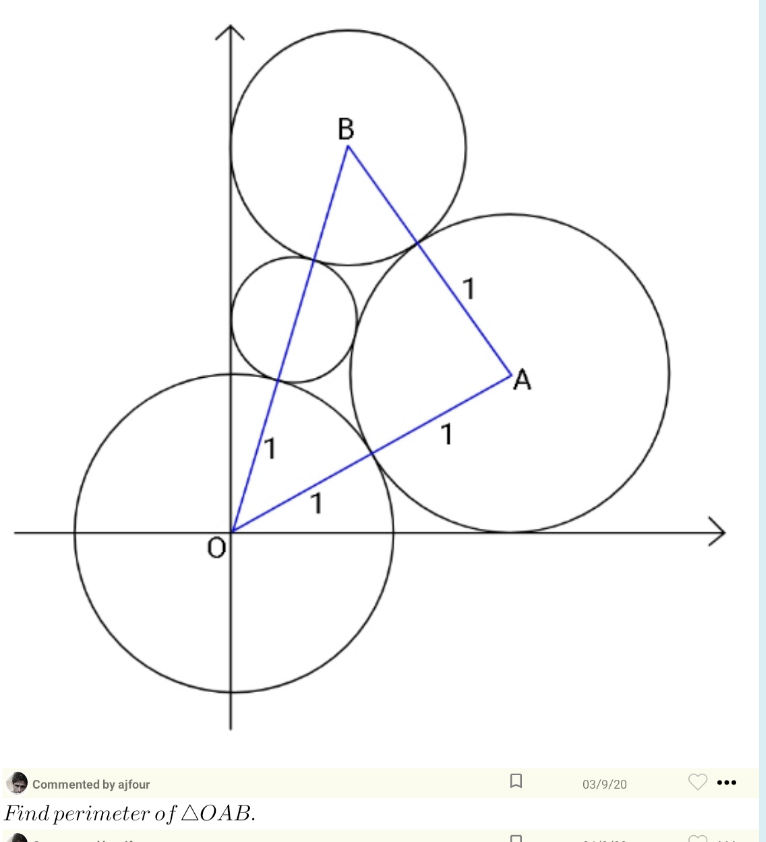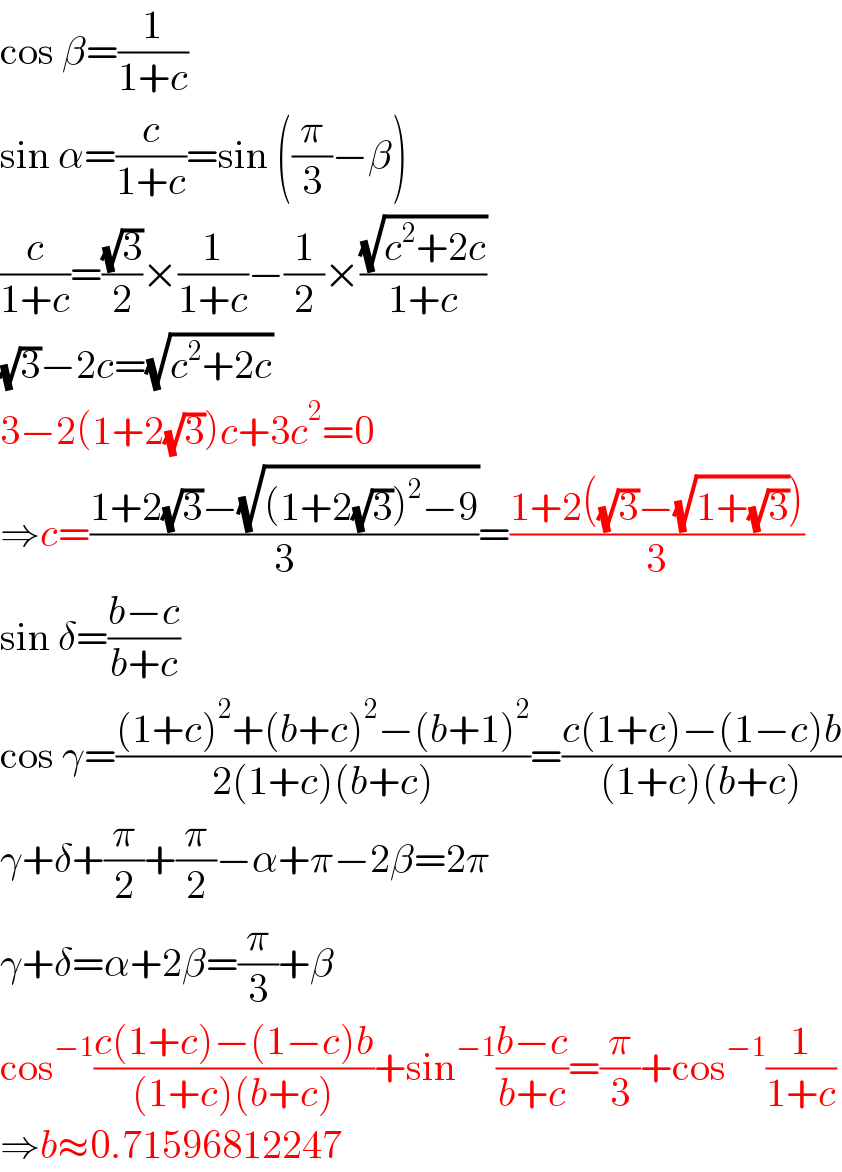
Question Number 216388 by Tawa11 last updated on 06/Feb/25

Commented by Tawa11 last updated on 06/Feb/25

$$\mathrm{Q111432} \\ $$
Answered by mr W last updated on 06/Feb/25

Commented by mr W last updated on 06/Feb/25

$$\mathrm{cos}\:\beta=\frac{\mathrm{1}}{\mathrm{1}+{c}} \\ $$$$\mathrm{sin}\:\alpha=\frac{{c}}{\mathrm{1}+{c}}=\mathrm{sin}\:\left(\frac{\pi}{\mathrm{3}}−\beta\right) \\ $$$$\frac{{c}}{\mathrm{1}+{c}}=\frac{\sqrt{\mathrm{3}}}{\mathrm{2}}×\frac{\mathrm{1}}{\mathrm{1}+{c}}−\frac{\mathrm{1}}{\mathrm{2}}×\frac{\sqrt{{c}^{\mathrm{2}} +\mathrm{2}{c}}}{\mathrm{1}+{c}} \\ $$$$\sqrt{\mathrm{3}}−\mathrm{2}{c}=\sqrt{{c}^{\mathrm{2}} +\mathrm{2}{c}} \\ $$$$\mathrm{3}−\mathrm{2}\left(\mathrm{1}+\mathrm{2}\sqrt{\mathrm{3}}\right){c}+\mathrm{3}{c}^{\mathrm{2}} =\mathrm{0} \\ $$$$\Rightarrow{c}=\frac{\mathrm{1}+\mathrm{2}\sqrt{\mathrm{3}}−\sqrt{\left(\mathrm{1}+\mathrm{2}\sqrt{\mathrm{3}}\right)^{\mathrm{2}} −\mathrm{9}}}{\mathrm{3}}=\frac{\mathrm{1}+\mathrm{2}\left(\sqrt{\mathrm{3}}−\sqrt{\mathrm{1}+\sqrt{\mathrm{3}}}\right)}{\mathrm{3}} \\ $$$$\mathrm{sin}\:\delta=\frac{{b}−{c}}{{b}+{c}} \\ $$$$\mathrm{cos}\:\gamma=\frac{\left(\mathrm{1}+{c}\right)^{\mathrm{2}} +\left({b}+{c}\right)^{\mathrm{2}} −\left({b}+\mathrm{1}\right)^{\mathrm{2}} }{\mathrm{2}\left(\mathrm{1}+{c}\right)\left({b}+{c}\right)}=\frac{{c}\left(\mathrm{1}+{c}\right)−\left(\mathrm{1}−{c}\right){b}}{\left(\mathrm{1}+{c}\right)\left({b}+{c}\right)} \\ $$$$\gamma+\delta+\frac{\pi}{\mathrm{2}}+\frac{\pi}{\mathrm{2}}−\alpha+\pi−\mathrm{2}\beta=\mathrm{2}\pi \\ $$$$\gamma+\delta=\alpha+\mathrm{2}\beta=\frac{\pi}{\mathrm{3}}+\beta \\ $$$$\mathrm{cos}^{−\mathrm{1}} \frac{{c}\left(\mathrm{1}+{c}\right)−\left(\mathrm{1}−{c}\right){b}}{\left(\mathrm{1}+{c}\right)\left({b}+{c}\right)}+\mathrm{sin}^{−\mathrm{1}} \frac{{b}−{c}}{{b}+{c}}=\frac{\pi}{\mathrm{3}}+\mathrm{cos}^{−\mathrm{1}} \frac{\mathrm{1}}{\mathrm{1}+{c}} \\ $$$$\Rightarrow{b}\approx\mathrm{0}.\mathrm{71596812247} \\ $$
Commented by Tawa11 last updated on 06/Feb/25

$$\mathrm{Great}\:\mathrm{sir}. \\ $$$$\mathrm{Weldone}\:\mathrm{sir}. \\ $$$$\mathrm{Thanks}\:\mathrm{sir}. \\ $$
Commented by mr W last updated on 06/Feb/25

Commented by mr W last updated on 06/Feb/25

$${A},{E},{G}\:{in}\:{diagram}\:{are}\:{not}\:{collinear}! \\ $$
